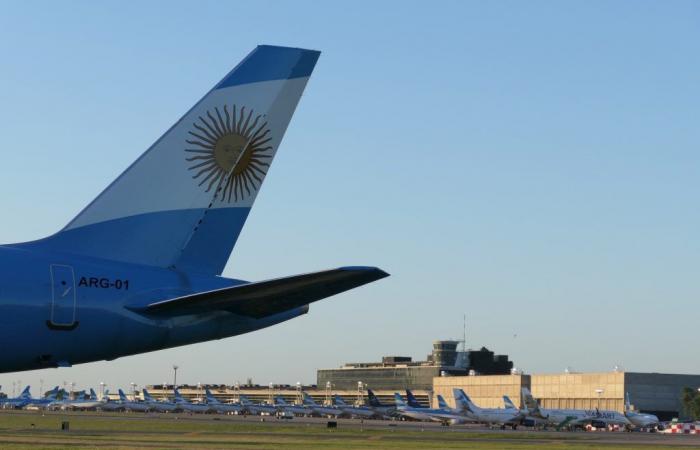There are 13 pages of Government Decree 70 that are dedicated to “opening” the skies of Argentina to foreign companies. They occupy the entire “Title 9” and replace, article by article, more than a hundred of the Aeronautical Code (17,285) and the Aerocommercial Law (19,030), both coming from the time of Onganía and Lanusse.
Those more than 100 modifications of the megadecree They are one step away from becoming firm: If there are no objections, on Saturday the 29th the six months of full validity of DNU 70. It will be the starting flag for the “open skies” policy that the president wants to carry out Javier Milei.
The intellectual author of this deregulation is Federico Sturzeneggerwho has been meeting with airline officials and executives for months.
According to some of those attending those meetings, Sturzenegger wants all regional airlines to be able to carve into the domestic market without legal obstacles. “I want Gol make San Pablo-Ezeiza-Bariloche”, would be one of his slogans.
Eight years ago, Macri’s Government moved forward with market deregulation with the marketing slogan of “Airplane Revolution.” The results of that policy were the entry of “low cost” airlines, of which today Flybondi and JetSMART remain as minority competitors of Argentinian airlines.
But also a few they were on the way. Some examples: Norwegian He left as soon as Alberto Fernández won the 2019 PASO; Avianca-Avian fell by the wayside after the 2018 devaluation and LATAM Argentinawhich had been established in 2005, was hit after the devaluation and closed during the pandemic.
The grouping The Campora liquidated the symbol of that “revolution of airplanes”, which was the airport of Dovecote. With the excuse of the pandemic, he made JetSMART and Flybondi move, first to Ezeiza and finally to Aeroparque. But the negotiation with these two American capital companies left them standing even better than they were in the precarious air station in western Buenos Aires.
Last year, with more than 17 million passengers in the cabotage market (29.1 million passengers transported in total), the “low cost” companies attracted from Aeroparque and Ezeiza almost 40%. The other two thirds of the market correspond to Aerolíneas Argentinas, which lost share but still increased the net number of passengers.
During the time of Sergio Massa as Minister of Economy, the three companies had access to a indirect state subsidy which consists of being able to settle dollars invoiced abroad under the MEP modality. That benefit It remains today under the administration of Milei and his minister Luis Caputoand allows local airlines to sell the “exported” dollars at a value in pesos above 40% of the official dollar.
It is thanks to this subsidy based on exchange rate what airlines is not asking the Treasury for funds. The only items that the Economy would make would be to reduce jobs: 250 have already signed a voluntary retirement and progress is also being made with an early retirement plan.
Going forward, the scaffolding for a new version of the “aircraft revolution” is being carried out by the Undersecretariat of Air Transport, headed by the notary and lawyer specialized in Aeronautical Law, Hernán Gómez. The Government has already made bilateral agreements withn Brazil, Chile, Peru, Ecuador and Uruguay that deregulate the frequencies. In the case of Uruguay and Chile, they also include the reciprocal possibility of making domestic flights.
Another possibility, according to conversations between officials and company executives, is to apply the “ninth freedom of the air” with other countries exclusively with free access for foreign-registered aircraft. (“exchange”, in the jargon) and not about the possibility that foreign crews can fly internal routes of the country.
From the local airlines they do not look so much towards Uruguay but towards the side of the Cordillera, above all, to LATAM. The Chilean-Brazilian airline is a conglomerate with more than 250 aircraft in the region (see table), of which 65 operate with Chilean registration, including a modern fleet of almost 20 Airbus A-321s, with 240 seats.
From LATAM, which completed a process of calling for creditors in the United States, come denying who are interested in returning to the Argentine cabotage market. But its competitors They don’t believe him.
“With the use of the planes that are currently used for the airlift with Santiago to make a single additional domestic flight, They are already becoming an unequal competitor, since they do not have our labor and tax burdens,” said private sector sources.
Another company that operators are looking at is JetSMART, which in Chile has 20 aircraft, compared to 8 for its Argentine subsidiary. “It should not be ruled out that some JetSMART aircraft with Chilean registration make internal flights in Argentina. But if the playing field is not leveled for everyone, it would leave its own Argentine subsidiary at a disadvantage,” the sources added. On the other hand, if the Government opted for an “interchange” system, JetSMAT Argentina would be better positioned.
In another company they were in favor of deregulations and the creation of a “favorable environment” for market development. But they were critical of a lack of unification of the command. “Among the agencies and regulatory entities, they still do not know how to act in favor of these intentions. Meanwhile, Other operators in markets such as Chile are clearly more advanced and prepared to take advantage of the government’s flexible measures“, they stressed.






